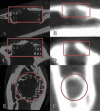Dual-energy computed tomography and micro-computed tomography for assessing bone regeneration in a rabbit tibia model
- PMID: 38472263
- PMCID: PMC10933353
- DOI: 10.1038/s41598-024-56199-8
Dual-energy computed tomography and micro-computed tomography for assessing bone regeneration in a rabbit tibia model
Abstract
To gain a more meaningful understanding of bone regeneration, it is essential to select an appropriate assessment method. Micro-computed tomography (Micro-CT) is widely used for bone regeneration because it provides a substantially higher spatial resolution. Dual-energy computed tomography (DECT) ensure shorter scan time and lower radiation doses during quantitative evaluation. Therefore, in this study, DECT and Micro-CT were used to evaluate bone regeneration. We created 18 defects in the tibial plateau of the rabbits and filled them with porous polyetheretherketone implants to promote bone regeneration. At 4, 8, and 12 weeks, Micro-CT and DECT were used to assess the bone repair in the defect region. In comparison to Micro-CT (152 ± 54 mg/cm3), the calcium density values and hydroxyapatite density values obtained by DECT [DECT(Ca) and DECT(HAP)] consistently achieved lower values (59 ± 25 mg/cm3, 126 ± 53 mg/cm3). In addition, there was a good association between DECT and Micro-CT (R = 0.98; R2 = 0.96; DECT(Ca): y = 0.45x-8.31; DECT(HAP): y = 0.95x-17.60). This study highlights the need to use two different imaging methods, each with its advantages and disadvantages, to better understand the bone regeneration process.
Keywords: Bone regeneration; Calcium density; DECT; Hydroxyapatite density; Micro-CT; Porous PEEK implants.
© 2024. The Author(s).
Conflict of interest statement
The authors declare no competing interests.
Figures





Similar articles
-
Biomechanical evaluation of the rabbit tibia after implantation of porous hydroxyapatite/collagen in a rabbit model.J Orthop Sci. 2016 Mar;21(2):230-6. doi: 10.1016/j.jos.2015.11.008. Epub 2016 Jan 14. J Orthop Sci. 2016. PMID: 26778623
-
Opportunistic screening for osteoporosis using enhanced images based on dual-energy computed tomography material decomposition: a comparison with quantitative computed tomography.Quant Imaging Med Surg. 2024 Jan 3;14(1):352-364. doi: 10.21037/qims-23-855. Epub 2023 Oct 27. Quant Imaging Med Surg. 2024. PMID: 38223059 Free PMC article.
-
Cortical measurements of the tibia from high resolution peripheral quantitative computed tomography images: a comparison with synchrotron radiation micro-computed tomography.Bone. 2014 Jun;63:7-14. doi: 10.1016/j.bone.2014.02.009. Epub 2014 Feb 26. Bone. 2014. PMID: 24582804
-
Dual-Energy Computed Tomography for Fat Quantification in the Liver and Bone Marrow: A Literature Review.Rofo. 2020 Dec;192(12):1137-1153. doi: 10.1055/a-1212-6017. Epub 2020 Sep 10. Rofo. 2020. PMID: 32911556 Review. English, German.
-
Dual-energy CT revisited with multidetector CT: review of principles and clinical applications.Diagn Interv Radiol. 2011 Sep;17(3):181-94. doi: 10.4261/1305-3825.DIR.3860-10.0. Epub 2010 Nov 14. Diagn Interv Radiol. 2011. PMID: 20945292 Review.
Cited by
-
Image reconstruction method based on backprojection filtration algorithm in C-arm computed tomography.Sci Rep. 2025 Mar 26;15(1):10360. doi: 10.1038/s41598-025-95474-0. Sci Rep. 2025. PMID: 40133623 Free PMC article.
-
Platelet-Rich Fibrin Synthetic Bone Graft Enhances Bone Regeneration and Mechanical Strength in Rabbit Femoral Defects: Micro-CT and Biomechanical Study.J Funct Biomater. 2025 Jul 28;16(8):273. doi: 10.3390/jfb16080273. J Funct Biomater. 2025. PMID: 40863293 Free PMC article.
References
MeSH terms
LinkOut - more resources
Full Text Sources

